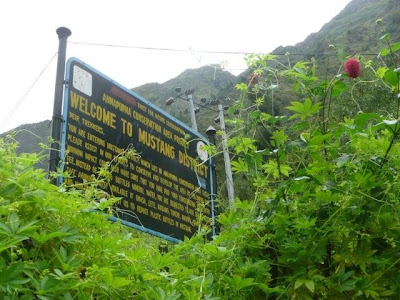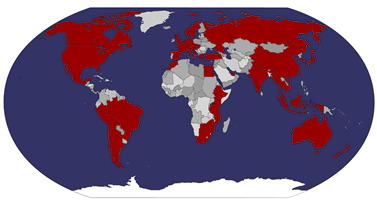My alarm is set for 7am, but I switch it off, who wants to get up in this rain?

Rain gear on
We eventually decide we can't wait any longer at gone half eight, so trudge over for a large pot of tea before setting off in what has become light rain. It soon regains its strength. With all the rain we didn’t feel like using the hot springs (Tatopani means hot water). Next time.

Tatopani
We pass livestock, donkey trains, and villages in the rain. It comes and goes, as does the cloud, rolling slowly up the valley, occasionally affording us views of the deep green valley.

The valley

Crossing a landslide
We stop for an early lunch at Dana, and I go for Dal Bhat. I don't need any refills. The owner laments the weather as she pulls on her raincoat and disappears. Reluctantly we trudge out afterwards.

Splash splash

Do you want to sit outside or in, Sir?
At times the moody clouds seem quite romantic, layers making ridges and hills silhouette into grey over distance.

Traffic jam

Goats heading down to celebrate the Dosain Festival

The valley narrows, this being the deepest gorge in the world, if you count Dhaulagiri (8167m, 7th highest) and Annapurna I (8091m, 10th highest) as the sides of the gorge - they are 38km apart. our hope is that this part will form the barrier which creates the Himalayan Rain Shadow, i.e. the rain will stop here. The experience of those descending suggests otherwise though, with rain well up towards Kagbeni and blanket cloud beyond that.

The flights are also a concern - we're supposed to be flying out on the 3rd, but they have now been cancelled 5 days in a row! The flights from Jomsom to Pokhara are pulled at the slightest inclement weather, as this valley acts as a giant funnel for air, with ferocious winds whistling up from the south mid-morning onwards.

Across from us is the large waterfall of Rupse Chhahara (1520m, “beautiful waterfall”) which once was so swollen it swept away half of the village that had been built around its base to take advantage of the views.

Mustang
We enter the Mustang district at Kopchepani (1620m). I hadn't realised that the district extended so far south. All those times I saw people wearing Mustang t-shirts I was so impressed, now I learn that they might have only got up to Ghasa!
Every so often a horse train will pass us, loaded up with bags of goods. They often don’t seem to be looked after - several times I saw nasty open flesh sores on their backs. They are generally accompanied by two or three men who shout continuously at them. Some have bells round their necks, and some have exotic colourful headgear.

Mustang (pronounced Moo-stang, nothing to do with the car or horse of the same name), and the Kali Gandaki have been major trade routes for centuries. Salt from salt lakes in Tibet used to be exchanged for rice and barley from Nepal’s middle hills. They also traded wool, livestock and butter for sugar, tea, spices, tobacco and manufactured goods from India. Foreign trekking groups have only been allowed into Upper Mustang, the part past Kagbeni, since 1992. The whole region is arid and Tibet-like, and it is thought that people have lived in caves in the valleys for thousands of years.
So we continue ascending, quite steeply now. Suresh's foot is giving him some trouble, so we stop for tea Bairo Thaplo (1890m), or 'Just on top of landslide'.

Suresh reads Rum Doodle
Suresh tells me there's an impressive mountain just across from us as we sip our mint tea. I try to dry my socks, but it's futile.

Steaming
We trek on and reach Ghasa (2120m), which seems very pleasant and takes forever to pass through.

It has stopped raining, what a blessing.

Might even be a mountain about

Being a porter is no fun

Big suspension bridges

Corn fields

Clouds thining
We're pushing on to Lete which Suresh yesterday told me was 30 minutes on. This morning he said 45mins- 1hr, and now the estimate has been revised to 'at least 2 hours'! It's now 6pm and will be dark soon. The Kali Gandaki is known as the Thak Khola here, so the people are called Thakali.

The latest wheel technology


Chorten
We pass some little half-naked boys, and I notice that one looks like me. I take his photo, then his friend yells “thief!” and holds out his hand, expecting payment.

Suresh tells me that the people at the bus station in Beni thought my hair looked like fried Gundruk, a local vegetable.
We trudge across an improvised path across a large landslide, then reach a river crossing.

A local tells us it's really muddy to walk round, so instead we follow his advise and slide down deep mud to a small bridge. Far better.
Suddenly all the rain is forgotten as the mighty Dhaulagiri rears into view ahead of us.

Even the puddles are beautiful
Nilgiri pokes his head out of the clouds on our right.

I'm so happy and excited, despite soggy boots and being tired and hungry.


It's dark as we approach Lete (2480m, pronounced Ley-tey), but we're staying in Kalobeni (2530m), the other side of Upper Lete. After a long suspension bridge in the pitch black, which LP says was clearly built for orang-utans - I see what they mean in that the handrails are about two feet high and six feet wide, no use for humans!, we rise up a short sharp climb to Lete, then carry on for some time. When the lodges and houses stop and we're completely in the dark, I suggest to Suresh that this may be the time to get my head torch out. This illuminates the mud as we finally reach our destination.
The planned hotel, See You Lodge is closed for extension and renovation, so we stay in Pine Forest Lodge instead, a grand place that Suresh suspects may be expensive, but in fact isn't. It's run as a training hotel for the local tourism school, and is almost empty - in the morning we meet a Canadian couple who must have retired early. Suresh thinks its empty because it has no permanent owner to foster relations with the guides who choose where their customers stay. Shame, as it's nice, with clean rooms and a good restaurant. We get some crackers to munch on whilst we wait for daal bhat ( guess who) and salad plus Swiss rosti for me. I'm feeling a little queer, and don't finish my tasty rosti. I'm feeling cold and am very wet, and worse - all of my spare clothes in my pack are wet too. I can't understand how this has happened - my pack ought to be reasonably waterproof on its own of its then covered with a good rain cover. How are the contents of the main chamber getting wet?
Up to our room we hit the sack almost immediately, I in my wet clothes which I need to dry. Let me tell you, climbing into bed with wet clothes on is not a pleasant experience. We pray for better weather the following day and sleep well.




No comments:
Post a Comment